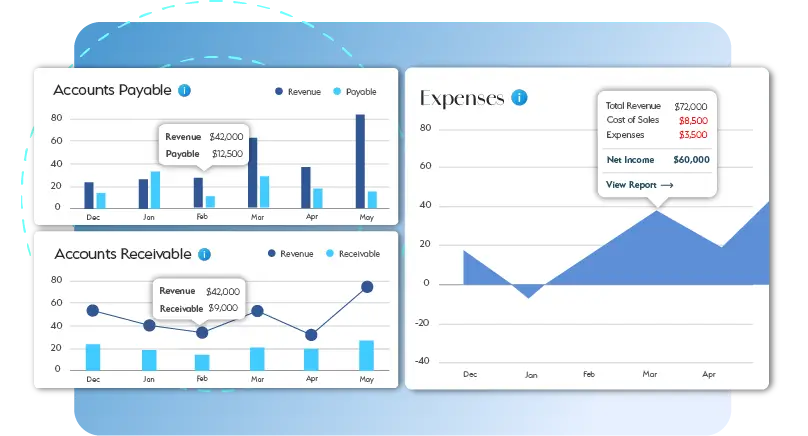-
100+
Clients Served
-
100000+
Invoices Processed Per Month
-
500+
Completed Projects
-
1000000+
Reconciliation in a Month
-
100+
Team Size
Master Your Metrics with Professional Ratio Analysis
Uncover the power in your numbers with our expert ratio analysis services. We turn complex financial data into clear, actionable insights, highlighting profitability, liquidity, and efficiency metrics to fuel your business growth. Whether it is identifying opportunities or tackling challenges, our analysis gives you the clarity to make confident, data-driven decisions and unlock new potential. Let your numbers drive your success!
Ratio Analysis Services We Offer
- Profitability Ratios
- Liquidity Ratios
- Efficiency Ratios
- Solvency Ratios
- Market Ratios
- Turnover Ratios
- Earnings Ratios

Challenges We Tackle for You
At Whiz Consulting, we tackle the crucial challenges businesses encounter in ratio analysis, providing reliable and actionable insights tailored to your needs.
Decoding Financial Complexity
Interpreting what ratios truly mean for your business can be daunting. We break down the numbers into clear, practical insights, making it easy for decision-makers to understand their impact.

Ensuring Data Accuracy
Missteps in calculations can skew results and lead to poor decisions. Our experts implement robust validation processes, ensuring your financial data is precise and dependable.

Enhancing Comparative Analysis
Lack of meaningful benchmarks can obscure performance evaluation. We provide in-depth industry comparisons, helping you gauge your business’s standing and uncover opportunities for growth.


Your Financial Compass for Growth
Navigating your business’s financial health is simpler than ever. Our expert ratio analysis services transform complex data into straightforward, actionable insights. From assessing profitability and liquidity to identifying growth opportunities, we deliver a clear roadmap to informed decision-making. Trust us to handle the details while you focus on driving success and achieving your goals with clarity and confidence.
- Tailored Onboarding
- Seamless Integration
- Data Migration Support
- Dedicated Account Manager
- No Disruption to Operations
- Scalable Solutions
Switching to Whiz is Simple!
Making the shift to a new accounting partner might seem daunting, but with Whiz, it's a hassle-free experience. We guide you every step of the way, ensuring a smooth transition with no downtime or disruptions. Focus on what you do best while we take over the responsibilities of your books.
Switch Now
Our Technology Partners
Empowering innovation with cutting-edge solutions designed to drive efficiency and transformation.
 Behind on
your books?
Behind on
your books?
Take advantage of Catch-Up Bookkeeping, and you’ll never feel behind on your books again.
Why Choose Us?
-

Innovative Workflow
We leverage cutting-edge technology and best practices to create streamlined workflows that ensure accuracy, efficiency, and timely delivery of your financial reports.
-

Seamless Collaboration
Our team works closely with you/team to ensure smooth communication and a deep understanding of your bookkeeping needs. Whether it's a quick update or a strategic discussion, we're always just a call away.
-

Decade of Experience
With over 10 years of industry experience, we have a proven track record of helping businesses from various sectors stay organized and financially sound.
-

Dedicated Experts
Our team consists of highly skilled, certified professionals who are dedicated to supporting your business. From accountants to financial analysts, we have the expertise to handle your unique challenges.
-

Real-Time Insights
Gain a clear, up-to-date view of your financial health round-the-clock. Our real-time reporting and dashboards provide actionable insights that help you make informed decisions and drive business growth.
-

Cost Savings
Outsourcing your accounting and bookkeeping with us means lower overhead costs. We offer scalable services tailored to your needs, helping you save on hiring, training, and maintaining an in-house team.
Client Testimonials
See how we've helped others achieve their financial goals with personalized solutions and expert guidance.
How It Works
We simplify the process to help you achieve your financial goals with ease.
-
Seamless Transition
We ensure a smooth, hassle-free transition, minimizing disruption to your operations.
-
Transparent Communication
We keep you informed at every step with clear, open communication.
-
Accurate Finances
Our team provides precise financial tracking to ensure everything stays on budget and within scope.
Have questions in mind? Find answers here...
Financial ratio analysis provides a clear view of a company’s financial health by evaluating key metrics like profitability, liquidity, and solvency. It simplifies financial data, making it easier to make strategic decisions and plan for growth.
Sectors such as retail, manufacturing, healthcare, and technology gain valuable insights from debt-to-asset ratio analysis. It allows businesses in these industries to evaluate their leverage and overall financial stability.
Regular reviews, either quarterly or annually, of debt-to-equity ratios are essential for staying ahead of financial risks. Consistent analysis helps businesses adapt to changing financial conditions and make informed decisions.
Absolutely! Ratio analysis, including equity-to-debt comparisons, provides a framework for benchmarking against industry standards. This helps businesses identify areas of strength and opportunities for improvement.
Outsourcing ensures precise calculations and expert interpretations of metrics like the debt-to-total-assets ratio. By leveraging professional services, businesses save time and gain actionable insights, enabling them to focus on core operations.
Thousands of business owners trust Whiz to manage their account
Let us take care of your books and make this financial year a good one.
Unlocking Business Insights with Expert Ratio Analysis Services
Effective financial management is key to business success, and ratio analysis plays a vital role in evaluating financial performance. Whether it’s analyzing profitability, assessing liquidity, or identifying risks, ratio analysis transforms raw financial data into actionable insights, enabling businesses to make informed decisions and stay ahead in a competitive landscape.
Get a CallRatio analysis is the process of evaluating a company’s financial health by comparing various metrics, such as assets, equity, and liabilities. It simplifies complex financial data, providing a clear understanding of areas like profitability, solvency, and efficiency.
- Improved Decision-Making: By analyzing metrics such as the debt to total assets ratio analysis, businesses can gauge their financial stability and risk levels.
- Performance Benchmarking: Comparing ratios, such as the equity to debt ratio analysis, against industry benchmarks helps identify strengths and weaknesses.
- Financial Planning: Insights from analysis of debt-to-equity ratio support better budgeting and resource allocation.
- Profitability Ratios: Measure a company’s ability to generate income relative to expenses.
- Liquidity Ratios: Assess the availability of liquid assets to cover short-term liabilities.
- Leverage Ratios: Metrics like the debt to asset ratio analysis indicate the extent of financial leverage and potential risks.
- Efficiency Ratios: Reflect how effectively a business utilizes its resources.
Outsourcing interpretation services for ratio analysis ensures accurate calculations and expert insights tailored to your business. These services provide:
- Comprehensive Reporting: Detailed evaluations, including debt to total assets ratio analysis and equity to debt ratio analysis, help identify areas for improvement.
- Benchmarking Expertise: Professionals deliver comparisons against industry standards, enabling businesses to stay competitive.
- Actionable Insights: By outsourcing, companies gain clear, concise recommendations for optimizing operations and financial strategies.
For businesses aiming to maximise growth and maintain financial health, ratio analysis services are an invaluable tool. By evaluating metrics such as the debt to asset ratio and leveraging expert interpretation services, businesses can uncover opportunities, mitigate risks, and drive success. Partner with skilled professionals to turn financial data into a roadmap for achieving your goals.











